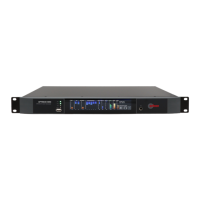Orban 5950 Technical Manual Operation 3-3
You will achieve best results if Engineering, Programming, and Management go out of their way to communicate
and cooperate with each other. It is important that Engineering understand the sound that Programming desires,
and that Management fully understands the trade-offs involved in optimizing one parameter (such as loudness) at
the expense of others (such as distortion or excessive density).
Never lose sight of the fact that, while the listener can easily control loudness, he or she cannot make a distorted
signal clean again. If such excessive processing is permitted to audibly degrade the sound of the original program
material, the signal is irrevocably contaminated and the original quality can never be recovered.
Fundamental Requirements: High-Quality Source Material and Accurate
Monitoring
A major potential cause of distortion is excess peak limiting. Another cause is poor quality source material,
including the effects of the station’s playback machines, electronics, and studio-to-transmitter link. If the source
material is even slightly distorted, that distortion can be greatly exaggerated by the OPTIMOD-5950—particularly if
a large amount of gain reduction is used. Very clean audio can be processed harder without producing
objectionable distortion. A high-quality monitor system is essential. To modify your air sound effectively, you must
be able to hear the results of your adjustments. In too many stations, the best monitor is significantly inferior to
the receivers found in many listeners’ homes!
Unfortunately, many contemporary CDs are mastered using levels of audio processing formerly used only by
“aggressively-processed” radio stations. These CDs are audibly distorted (sometimes blatantly so) before any
further OPTIMOD processing. The result of 5950 processing can be to exaggerate this distortion and make these
recordings noticeably unpleasant to listen to over the air. There is a myth in the record industry that applying
“radio-style” processing to CDs in mastering will cause them to be louder or will reduce the audible effects of on-
air processing. In fact, the opposite is true: these CDs will not be louder on air, but they will be audibly distorted
and unpleasant to listen to, lacking punch and clarity.
Another unfortunate trend is the tendency to put so much high frequency energy on the CDs that this energy
cannot possibly survive the FM pre-emphasis / de-emphasis process. Although the 5950 loses less high frequency
energy than many previous Orban processors (due to improvements in high frequency limiting and clipping
technology), it is nevertheless no match for CDs that are mastered so bright that they will curl the vinyl off car
dashboards. We hope that the record industry will come to its senses when it hears the consequences of these
practices on the air.
If the waveforms on a given CD are noticeably clipped, it may be possible to improve the sound by using de-
clipping software, which attempts to reconstruct the clipped-off sections of the waveform by extrapolating the
clipped-off part of the waveform from audio that surrounds it. Beyond this, our best advice regarding 5950
processing is to use slow multiband release times and considerable band 4 to band 5 coupling, which will not
further exaggerate distortion already on the CD. As of this writing, two audio restoration programs that offer de-
clipping are Diamond Cut DC8 and iZotope Rx.

